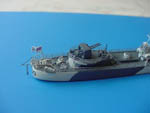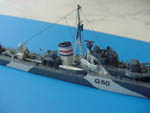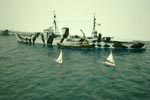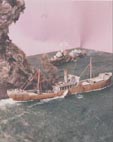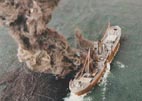Alexandria June 1941
|
The diorama depicts the scene when Naiad arrives in Alex passing Kimberley and Ajax at anchor. In the busy harbour are two Egyptian feluccas, gibing in the steady breeze in an attempt to keep out of the cruiser's way. Kimberley is wearing a two-tone disruptive camouflage consisting of AP507a and AP507c. Ajax is wearing a dazzle scheme based on W.W.1 practice. The colours consist of black and white. Her decks are painted in AP507a which is evident in photos taken slightly earlier. Naiad is wearing an unusual type of disruptive design which she had worn since her completion in Mid 1940. The colours are AP507a, AP507b and AP507c. Her wooden decks were painted. Kimberley is a WEM Kashmir kit whilst both Ajax and Naiad are Skytrex models. The Naiad is a modified Skytrex Dido. A variety of WEM etch brass sets were used to detail the ships. |
||
HMS Penelope


